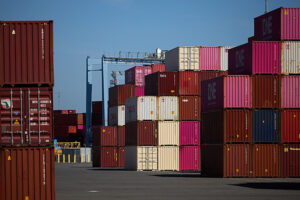Coronavirus: Northern Italy quarantines 16 million people
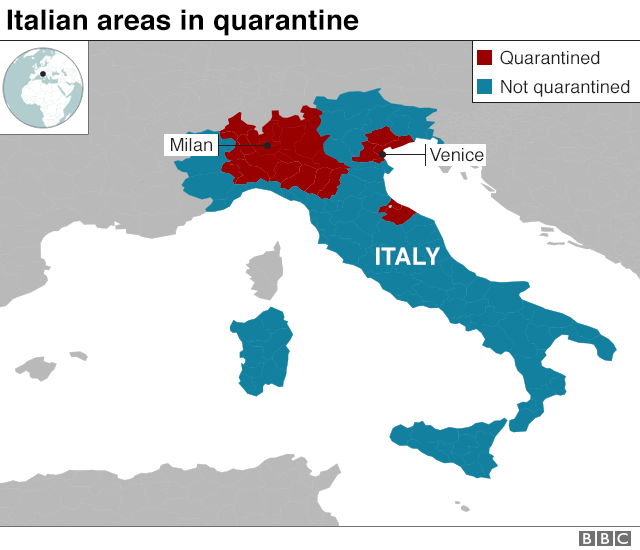
Italy has placed up to 16 million people under quarantine as it battles to contain the spread of coronavirus.
Anyone living in Lombardy and 14 other central and northern provinces will need special permission to travel. Milan and Venice are both affected.
Prime Minister Giuseppe Conte also announced the closure of schools, gyms, museums, nightclubs and other venues across the whole country.
The measures, the most radical taken outside China, will last until 3 April.
Italy has seen the largest number of coronavirus infections in Europe, with the number of confirmed cases jumping by more than 1,200 to 5,883 on Saturday.
Among the latest people to test positive is the army’s chief of staff. Salvatore Farina said he felt well and was self-isolating.
The strict new quarantine measures affect a quarter of the Italian population and centre on the rich northern part of the country that powers its economy.
The death toll in Italy has passed 230, with officials reporting more than 36 deaths in 24 hours.
The health system is under immense strain in Lombardy, a northern region of 10 million people, where people are being treated in hospital corridors.
“We want to guarantee the health of our citizens. We understand that these measures will impose sacrifices, sometimes small and sometimes very big,” Prime Minister Conte said as he announced the measures in the middle of the night.

- EASY STEPS: What can I do?
- A SIMPLE GUIDE: What are the symptoms?
- GETTING READY: How prepared is the UK?
- MAPS AND CHARTS: Visual guide to the outbreak
- VIDEO: The 20-second hand wash

Under the new measures, people are not supposed to be able to enter or leave Lombardy, where Milan is the main city.
The same restrictions apply to 14 provinces: Modena, Parma, Piacenza, Reggio Emilia, Rimini, Pesaro and Urbino, Alessandria, Asti, Novara, Verbano Cusio Ossola, Vercelli, Padua, Treviso and Venice.
“There will be no movement in or out of these areas, or within them, unless for proven work-related reasons, emergencies or health reasons,” Mr Conte told reporters.
“We are facing an emergency, a national emergency. We have to limit the spread of the virus and prevent our hospitals from being overwhelmed.”
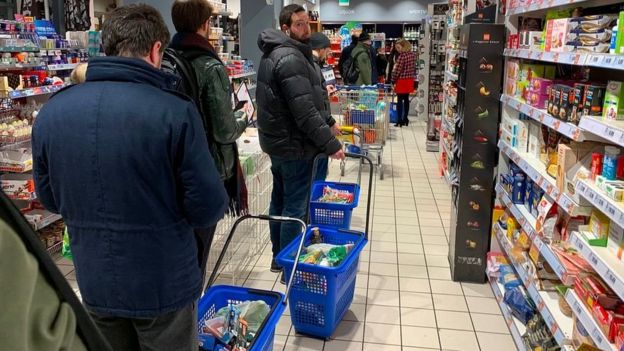 Image copyrightGETTY IMAGES
Image copyrightGETTY IMAGESHowever, transport in and out of the regions affected continues. Flights continued to arrive at Milan’s Malpensa and Linate airports on Sunday, though some scheduled flights were cancelled.
Chris Wood, a 26-year-old from London said he and his girlfriend had cut their holiday in Italy short and were waiting for a flight home from Venice.
“The initial announcement that Venice was in lockdown was quite terrifying but everything at the airport is pretty calm,” he said. “I was in a bit of a panic as I thought we were going to be stuck in Venice for a month.”


Last week was critical to seeing if Italy’s coronavirus response had managed to halt the spread. If the numbers had begun to tail off, it would have suggested the containment measures had worked. They haven’t.
With cases still surging, the government has moved to the next stage – and it’s a dramatic step up. It’s not quite a complete lockdown – planes and trains are still running and access will be permitted for emergency or essential work reasons. But police will be able to stop people and ask why they’re trying to enter or leave the areas covered.
The question is whether this is all too late. It’s believed the virus was circulating in Italy for weeks before it was detected. And there have now been cases in all 22 regions of the country. The government is now taking the most extensive containment measures outside of China. But is this a case of trying to shut the stable door after the horse has bolted?

What are the details of the new restrictions?
Weddings and funerals have been suspended, as well as religious and cultural events. Cinemas, nightclubs, gyms, swimming pools, museums and ski resorts have been closed.
Restaurants and cafes in the quarantined zones can open between 06:00 and 18:00 but customers must sit at least 1m (3ft) apart.
People have been told to stay at home as much as possible, and those who break the quarantine could face three months in jail.
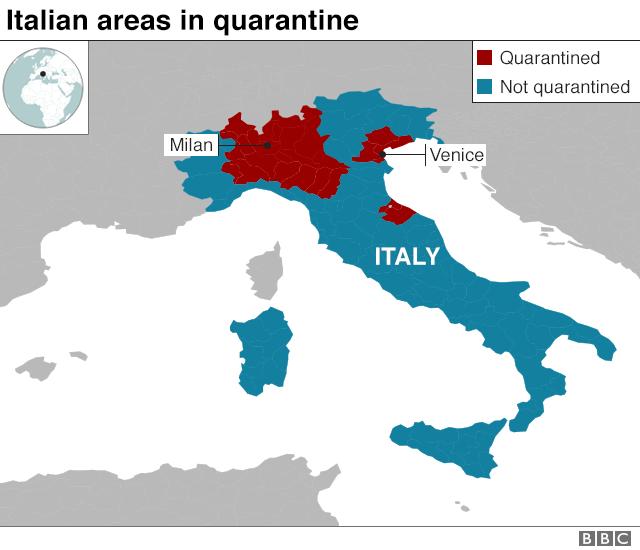

The World Health Organization (WHO) chief Tedros Adhanom Ghebreyesus praised Italy for making “genuine sacrifices” with the restrictions. Until now only about 50,000 people in northern Italy had been affected by quarantines.
Last week the government announced the closure of all schools and universities across the country for 10 days.
What is the situation elsewhere?
The number of infections worldwide is almost 105,000, the WHO says, with nearly 3,600 deaths. Most of the fatalities have been in China, where the virus originated in December.
But the country on Sunday reported its lowest number of new infections in a single day since January – an indication that the virus’s spread there is slowing.
There were 40 new cases on Saturday, less than half the number reported on Friday. Twenty-seven new deaths were reported – the lowest figure in more than a month – and all were in Wuhan, where the outbreak began.
Iran, one of the worst hotspots outside China, has now confirmed almost 6,000 infections and 145 deaths.
However, the real figure is believed to be much higher. One report on Sunday, quoting a government envoy, said there had been 200 deaths in the northern Gilan province alone – but the figures were later removed.
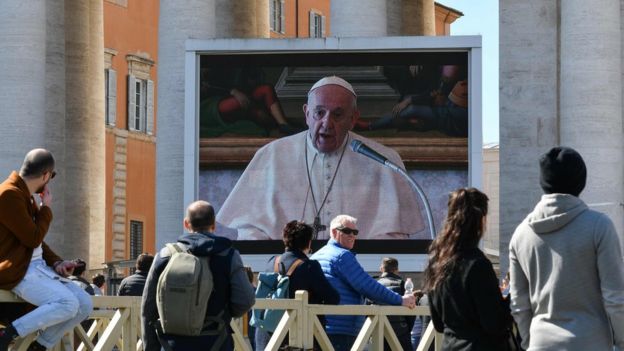 Image copyrightAFP
Image copyrightAFPIn other developments:
- Saudi Arabia has put the governorate of Qatif in the oil-producing Eastern Province into lockdown. The cases confirmed in Qatif – where the Shia minority live – have all been traced back to Iran
- A hotel being used as a coronavirus quarantine facility in the Chinese city of Quanzhou collapsed, killing at least six people
- Pope Francis delivered his first live-streamed Sunday prayer to avoid the usual crowds forming – he said he was “close through prayer” with those suffering from the epidemic
- In the US, a cruise ship with 3,533 passengers and crew held off the coast near San Francisco after 21 people tested positive for the disease has been directed to the nearby port of Oakland
- An individual who attended a conservative political conference last week that President Trump and Vice-President Mike Pence spoke at has been confirmed to have the virus
On Sunday South Korean officials said 272 new cases had been reported over the previous 24 hours, bringing the total to 7,313 – the largest of any country outside China.

In the US more than 400 cases have been reported, and the death toll is 19.
In New York, cases jumped from 44 on Friday to 76 and Governor Andrew Cuomo declared a state of emergency.
South America recorded its first coronavirus death – a 64-year-old man in Argentina.
In Australia, a man in his 80s became the third person to die there from the virus.
- Parents stressed by Italy’s coronavirus shutdown
- A cancer patient’s border plea: What happened next?
- Is India prepared for a coronavirus outbreak?
Among other countries to report a rise in the total number of cases are: France (to 949); Germany (939); Spain (589); the UK (273); the Netherlands (188).
Colombia, Bulgaria, Costa Rica, Malta, the Maldives and Paraguay have, meanwhile, all reported their first cases.
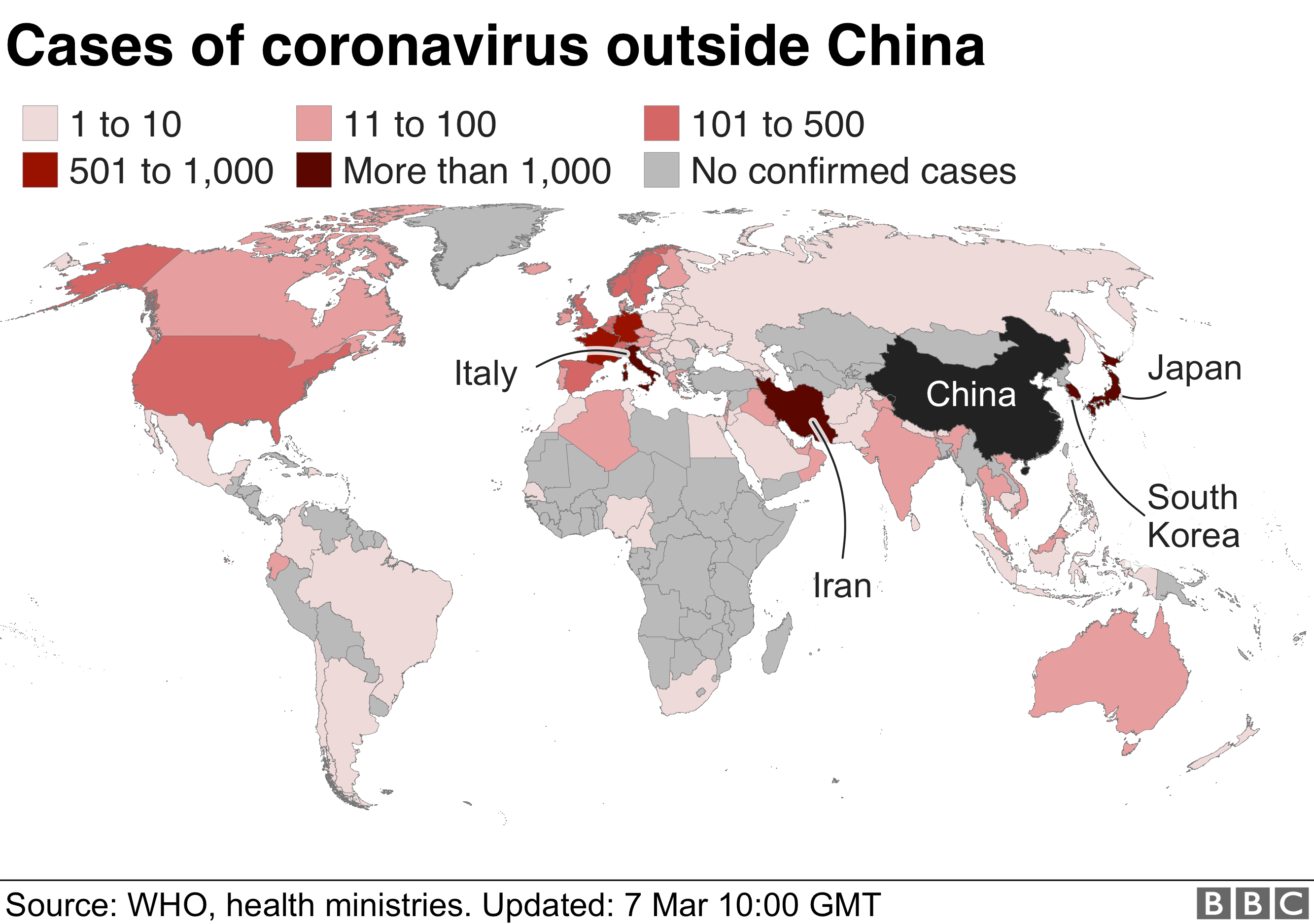

You might be interested in watching:

![]()


